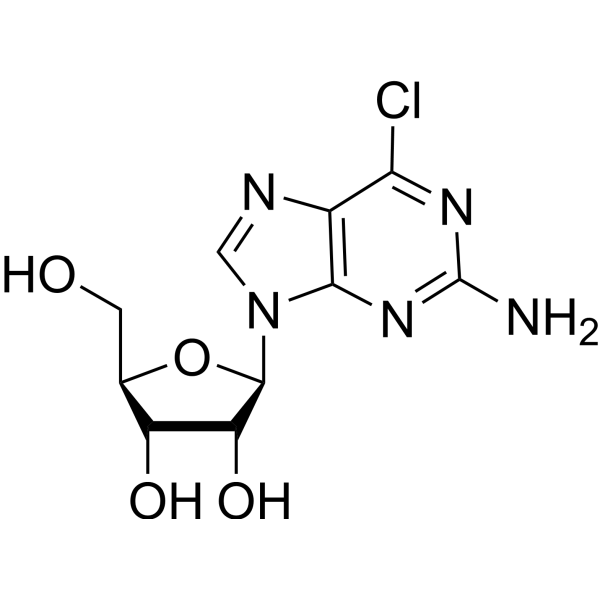29411-74-3
| Name | 2-(2-amino-6-λ1-selanylpurin-9-yl)-5-(hydroxymethyl)oxolane-3,4-diol |
|---|---|
| Synonyms |
6-Selenoguanosin
Guanosine,6-seleno 6-Selenoguanosine 2-Amino-6-seleno-9-(ss-D-ribofuranosyl)purin 2-(2-amino-6-selanylpurin-9-yl)-5-(hydroxymethyl)oxolane-3,4-diol 2-(2-amino-6 |
| Molecular Formula | C10H14N5O4Se |
|---|---|
| Molecular Weight | 347.20900 |
| Exact Mass | 348.02100 |
| PSA | 142.44000 |
|
Version 1.2
Regulation (EC) No 1907/2006 1 - Product and Company Information Product Name6-SELENOGUANOSINE APPROX. 80% 2 - Hazards Identification SPECIAL INDICATION OF HAZARDS TO HUMANS AND THE ENVIRONMENT Toxic by inhalation, in contact with skin and if swallowed.
3 - Composition/Information on Ingredients Product NameCAS #EC noAnnex I Index Number 6-SELENOGUANOSINE APPROX. 80%29411-74-3 NoneNone FormulaC10H13N5O4Se Molecular Weight 346,2000 AMU SynonymsGuanosine, 6-seleno- (9CI) * NSC 137679 * 6-Selenoguanosine 4 - First Aid Measures AFTER INHALATION If inhaled, remove to fresh air. If breathing becomes difficult, call a physician. AFTER SKIN CONTACT In case of skin contact, flush with copious amounts of water for at least 15 minutes. Remove contaminated clothing and shoes. Call a physician. AFTER EYE CONTACT In case of contact with eyes, flush with copious amounts of water for at least 15 minutes. Assure adequate flushing by separating the eyelids with fingers. Call a physician. AFTER INGESTION If swallowed, wash out mouth with water provided person is conscious. Call a physician. SIGMAwww.molbase.com 5 - Fire Fighting Measures EXTINGUISHING MEDIA Suitable: Carbon dioxide, dry chemical powder, or appropriate foam. SPECIAL PROTECTIVE EQUIPMENT FOR FIREFIGHTERS Wear self-contained breathing apparatus and protective clothing to prevent contact with skin and eyes. 6 - Accidental Release Measures PROCEDURE(S) OF PERSONAL PRECAUTION(S) Wear respirator, chemical safety goggles, rubber boots, and heavy rubber gloves. METHODS FOR CLEANING UP Sweep up, place in a bag and hold for waste disposal. Avoid raising dust. Ventilate area and wash spill site after material pickup is complete. 7 - Handling and Storage STORAGE Store at -20°C 8 - Exposure Controls / Personal Protection ENGINEERING CONTROLS Use only in a chemical fume hood. PERSONAL PROTECTIVE EQUIPMENT Respiratory Protection: Use respirators and components tested and approved under appropriate government standards such as NIOSH (US) or CEN (EU). Where risk assessment shows air-purifying respirators are appropriate use a full-face particle respirator type N99 (US) or type P2 (EN 143) respirator cartridges as a backup to engineering controls. If the respirator is the sole means of protection, use a full-face supplied air respirator. Hand Protection: Compatible chemical-resistant gloves. Eye Protection: Chemical safety goggles. 9 - Physical and Chemical Properties AppearancePhysical State: Solid PropertyValueAt Temperature or Pressure pHN/A BP/BP RangeN/A MP/MP RangeN/A Flash PointN/A FlammabilityN/A Autoignition TempN/A Oxidizing PropertiesN/A Explosive PropertiesN/A Explosion LimitsN/A Vapor PressureN/A Partition CoefficientN/A ViscosityN/A SIGMAwww.molbase.com Vapor DensityN/A Saturated Vapor Conc. N/A Evaporation RateN/A Bulk DensityN/A Decomposition Temp.N/A Solvent ContentN/A Water ContentN/A Surface TensionN/A ConductivityN/A Miscellaneous DataN/A SolubilityN/A 10 - Stability and Reactivity STABILITY Stable: Stable. Conditions of Instability: Air and light sensitive. HAZARDOUS DECOMPOSITION PRODUCTS Hazardous Decomposition Products: Carbon monoxide, Carbon dioxide, Nitrogen oxides, Selenium/selenium oxides. HAZARDOUS POLYMERIZATION Hazardous Polymerization: Will not occur 11 - Toxicological Information RTECS NUMBER: UP0790170 ACUTE TOXICITY LD50 Oral Mouse 137,000000 mg/kg LD50 Intraperitoneal Mouse 126 MG/KG LD50 Subcutaneous Mouse 58840 UG/KG SIGNS AND SYMPTOMS OF EXPOSURE Chronic contact with selenium compounds may cause garlic odor of breath and sweat, dermatitis, and moderate emotional instability. ROUTE OF EXPOSURE Multiple Routes: May cause irritation. Harmful if swallowed, inhaled, or absorbed through skin. CONDITIONS AGGRAVATED BY EXPOSURE The toxicological properties have not been thoroughly investigated. 12 - Ecological Information SIGMAwww.molbase.com No data available. 13 - Disposal Considerations SUBSTANCE DISPOSAL Bury in a landfill site approved for the disposal of chemical and hazardous wastes. Observe all federal, state, and local environmental regulations. 14 - Transport Information RID/ADR UN#: 3283 Class: 6.1 PG: III Proper Shipping Name: Selenium compound, n.o.s. IMDG UN#: 3283 Class: 6.1 PG: III Proper Shipping Name: Selenium compound, n.o.s. Marine Pollutant: No Severe Marine Pollutant: No Technical Name: Required IATA UN#: 3283 Class: 6.1 PG: III Proper Shipping Name: Selenium compound, n.o.s. Inhalation Packing Group I: No Technical Name: Required 15 - Regulatory Information CLASSIFICATION AND LABELING ACCORDING TO EU DIRECTIVES INDICATION OF DANGER: T Toxic. R-PHRASES: 23/24/25 Toxic by inhalation, in contact with skin and if swallowed. S-PHRASES: 36/37/39-45 Wear suitable protective clothing, gloves, and eye/face protection. In case of accident or if you feel unwell, seek medical advice immediately (show the label where possible). Caution: Substance not yet fully tested (EU). COUNTRY SPECIFIC INFORMATION Germany WGK: 3 Self-Classification 16 - Other Information WARRANTY The above information is believed to be correct but does not purport to be all inclusive and shall be used only as a guide. The information in this document is based on the present state of our SIGMAwww.molbase.com knowledge and is applicable to the product with regard to appropriate safety precautions. It does not represent any guarantee of the properties of the product. Inc., shall not be held liable for any damage resulting from handling or from contact with the above product. See reverse side of invoice or packing slip for additional terms and conditions of sale. Copyright 2010 Co. License granted to make unlimitedpaper copies for internal use only. DISCLAIMER For R&D use only. Not for drug, household or other uses. SIGMAwww.molbase.com SECTION 16 - ADDITIONAL INFORMATION N/A |
CHEMICAL IDENTIFICATION
HEALTH HAZARD DATAACUTE TOXICITY DATA
|
| Risk Phrases | 23/24/25 |
|---|---|
| RIDADR | UN 3283 6.1/PG 3 |
|
~93% 
29411-74-3 |
| Literature: Scovill, John P. Phosphorus, Sulfur and Silicon and the Related Elements, 1992 , vol. 70, # 1/2 p. 1 - 2 |
| Precursor 1 | |
|---|---|
| DownStream 0 | |
